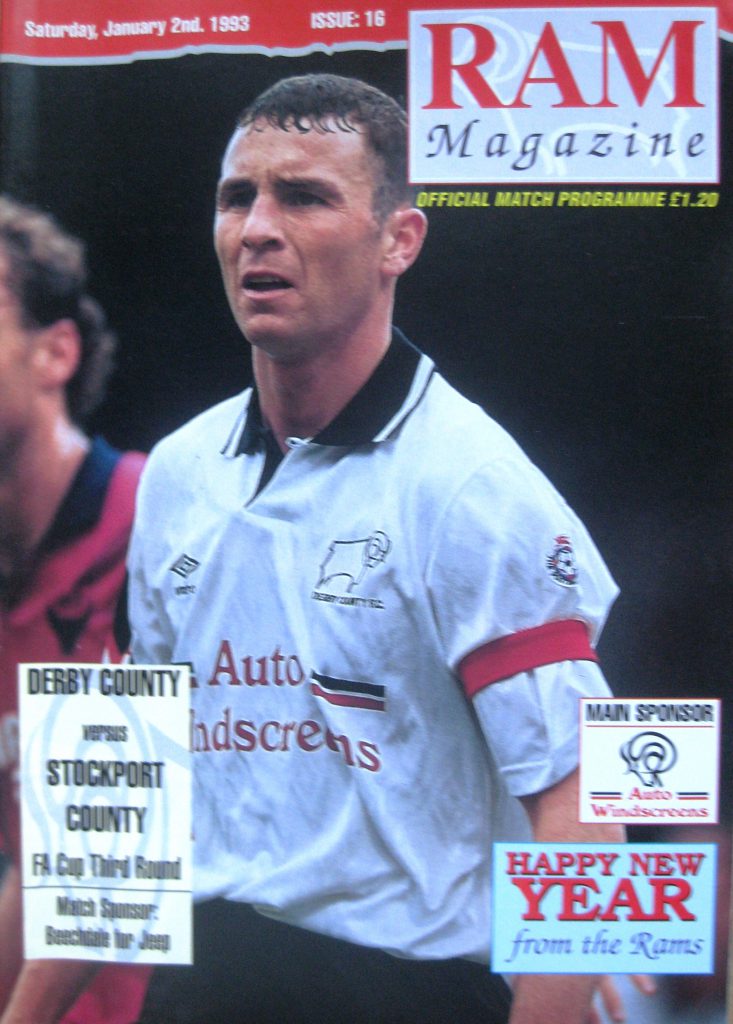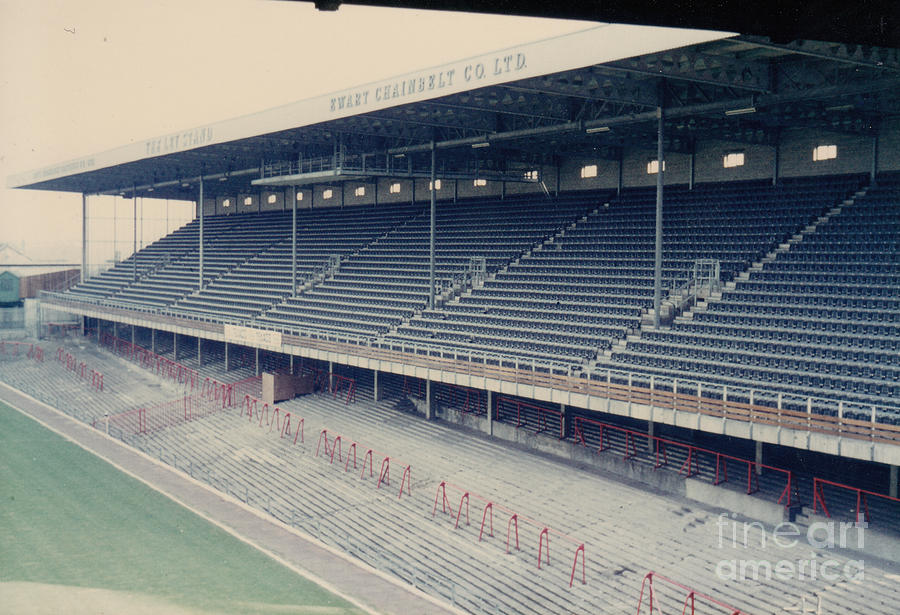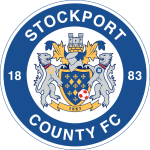..
| Only County Visit: | Saturday 2nd January 1993 |
| Competition: | FA Cup – (Round 3) |
| Result: | Derby County 2 – 1 Stockport County |
| Attendance: | 17,960 |
| Away Trip: | 63 |
| Away Day: | 250 |
| County Line-up | 1 Neil Edwards; 2 Lee Todd; 3 Paul R Williams; 4 Dave Miller; 5 Tony Barras; 6 Bill Williams; 7 Jim Gannon (12 David Frain); 8 Peter Ward; 9 Kevin Francis; 10 Chris Beaumont; 11 Andy Preece (14 Brian McCord) |
| Scorer: | Brian McCord |
| Manager: | Danny Bergara |
| County Visits: | 1 |
..
THE BASEBALL GROUND LEAVES ME WITH AN INDELIBLE IMPRESSION..

The Baseball Ground certainly made an indelible impression on me. And not only indelible but also lifelong.
..
You might be tempted to ask how a mundane FA Cup game could have such a big impact. Was it the ground? No although I can look back 27 years and recall it as an interesting stadium, with character and atmosphere. Was it a Cup upset? No although we did take a team from a Tier higher to a more than close finish. Was it the city? Hardly, because in my preceding 38 years; on that day, and in the time since then I have never been to the centre. (Which comes as a surprise to me – the County Ground, home to Derbyshire CCC, is somewhere I would have expected to go. But sadly not – I’ve preferred watching DCCC at Buxton and Chesterfield). Was it the scenic trip over the Peak District, (one that I did on business many times in later years)?
No, because the day was shrouded in mist, precluding any views of the scenery, and to be quite honest made the return drive hard work as the mist became fog as the night closes in and the temperature dropped. So, the normal reasons for recalling an Away Day aren’t ticked by this trip.
And it’s not really a mental recollection but a physical one. It was a biggish game for County fans; somewhere we hadn’t been since a 5-1 League Cup defeat in 1968 and prior to that a handful of Division 3, (Tier 3), games in the 50’s. So, it’s fair to say that few Hatters fans had ever seen their team at a ground not too far, (60 miles or so). It promised to be a good following. And it was.
We were allocated one half of the bottom tier of the Ley Stand. Now, I’m not too sure how decisions were taken in those days as to when turnstiles should be closed because capacity had been reached. If there were any rules, then it’s a fair bet they weren’t applied that early January afternoon in 1993. There were simply far too many let into the enclosure. The ebbs and flows of any game naturally lead to movement in a crowd, and particularly on terracing. Normally regulated through “crush barriers” which provide for a measure of control, crowd surges are not dangerous. So, take a look at the picture. We were on the bottom tier of the stand, at the far end.
..

The Ley Stand
..
The normal configuration of crush barriers being staggered simply isn’t there – just a single row half-way down the terrace, with another row many steps to the rear. I was just to the rear of the lower row of barriers, having stationed myself there after a relatively early arrival. As kick-off approached things began to get more than crowded, and after the game started more than uncomfortable.
County attacked the Normanton Stand to our left, and whilst very crowded there wasn’t much movement in our part of the crowd. Most will have had a decent view, (the mist notwithstanding!). Derby went into the break 1-0 up, which left us to chase the game in the second half, now attacking the goal at the Osmaston End right in front of us.
With each Hatters attack the crowd surged forward, and it quickly became apparent that moving in front of the crush barrier was a good idea. I’d no wish to become the meat in a sandwich of a metal bar and hundreds of people behind me. But frankly it was no better in my new position.
Throughout the second half any County attack led to a rush forward, with no chance of standing one’s ground. I just had to go with the flow. On occasions the movement came with feet barely on the ground, and after Brian McCord’s equaliser the pandemonium was such that I ended up near the front and about 20 yards to the side of where I’d started. Derby scored a very late winner, courtesy of a Dave Miller own goal, and with a lot of disappointment, but also some relief that I was out of the crush, I departed.
Now, not knowing Derby, and with sat-nav still a gleam in some inventors’ eye, I’d followed the AA yellow and black signs directing traffic to “Football Car Parking”. It’s not a thing I would have normally done – previous, and limited, experience had taught me that such car parks were generally ill-policed, in terms of damage, and almost certainly a route march from the ground. But my knowledge of Derby was less than zero, and therefore with great reluctance I had headed for one. Fortunately, when I got back to the car, any fears about damage were ill-founded, but the place I ended up must have been a mile away from the Baseball Ground.
It was little surprise as the arena itself was hemmed in by a huge foundry, and a myriad of terraced streets, with no chance to park anywhere nearer. That mile walk back to the carpark was agony. With each step a pain in my back, which hadn’t been there 2 hours earlier, got worse. The crowd congestion and being swept on a tide, and some vain attempts to stand my ground, had placed a stress on my back which had in non-medical terms “done something”. The drive back was simply awful. Simple dipping the clutch caused a shooting pain, and the thickening fog as I got to the outskirts of Buxton, made it one of the most singularly difficult trips I had made. And it remains that way.
As does my back. A myriad of hospital and physio sessions made little difference, and only by trial and error have I found that swimming does help. But there is no doubt that the Baseball Ground has left an indelible, and permanent, impression on me.
Turning to the ground. I’d set out with an impression about the place. It was the home of a provincial team which had turned English football upside down as they picked up two Championships, led by the great Brian Clough. Watching Match of the Day in the 70’s the pitch always seemed to be a morass, with deep cloying mud, more akin to a local park pitch. But what had also taken my eye was how claustrophobic the ground looked.
..

Stands on all four sides, three of them double decker, all aimed to maximise the capacity in what was an incredibly small footprint.
..
The stands seemed on top of the pitch, with only a small track around it. Purportedly the pitch was one of the smallest in the League, and the whole ground was, in my view, atmospheric.
And that was certainly the case. The Main Stand, (which faced the cameras and was opposite where we were stationed) went the length of the pitch and was the only single tier one in the ground. To our left was the Normanton Stand. The top tier seated of course, and underneath what had presumably been standing at one point had also been converted. At the other end was the Osmaston Stand, a mirror image. The Ley Stand where we were might have had an issue or two, (at least from my perspective), but was an integral part of a good ground. A real football ground, so different from the anodyne; sanitized stadia we have today. And despite my “injury” that day I still think of it as a proper ground. All that was needed was a better crush barrier arrangement, and, of course, the ability to limit entrants to a specified number. Take a look at the photos and make your own judgement.
..

..
The Baseball Ground is now, of course, long gone. I’m glad I went there. We’ve never had the chance to go to Pride Park. I’ve heard reasonable things about it, but I dare say it isn’t a patch on its predecessor. And it makes me think about what makes for a good ground, (in my opinion anyway). I’ve never been a big drinker, and certainly since my transplant a non-drinker. Not because I’m precluded from it, but simply because all the chemo I had pumped into me means I don’t have a taste for it anymore. So, unlike many of my fellow travellers, a decent pub in the environs isn’t a necessity.
What I’m looking for is somewhere with a bit of atmosphere; individuality; a decent view and a warm welcome from the locals. Getting all 4 in one place is difficult, if not nigh on impossible. For atmosphere I’d pick the Stadium of Light any day; for individuality the Deepdale of old or the Northolme in our recent years; for a decent view most of the new grounds, and for a warm welcome without a shadow of a doubt Stonebridge Road Ebbsfleet. Put the individual characteristics from those 4 together and it’s be my perfect ground. But all of that is naturally subjective. Feel free to disagree!!
May 2020
..
VISITS
..
| Day | Date | Competition | Tier / Round | Opponents | Res | F | A | Crowd | Away Day |
| Sat | 02/01/93 (Highlights) | FA Cup | Round 3 | Derby County | L | 1 | 2 | 17,960 | 250 |
..
ON MY JOURNEY WITH COUNTY AROUND 180 GROUNDS
..
Previously – GOLDSTONE GROUND Next stop – HOME PARK

Yes the ley stand for away fans was an experience poor views from the back due to the overhanging top tier also poor right at the front as below pitch level never the less you could get a good atmosphere going without taking many down due to the low clearance between the top tier and the terrace I enjoyed it but not the police escort to the train station that got rather wild memories